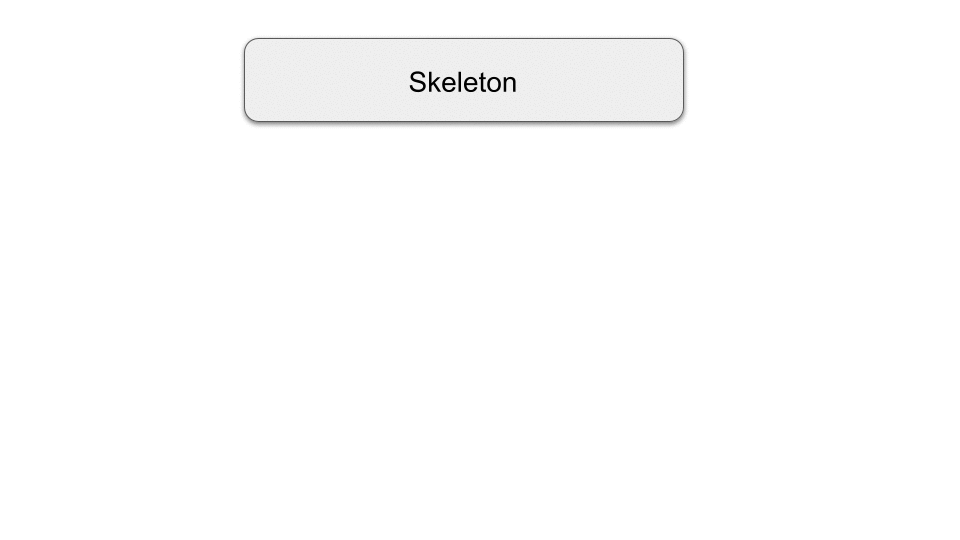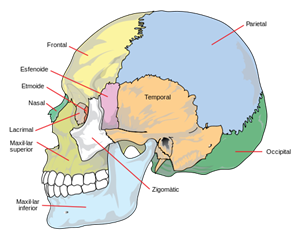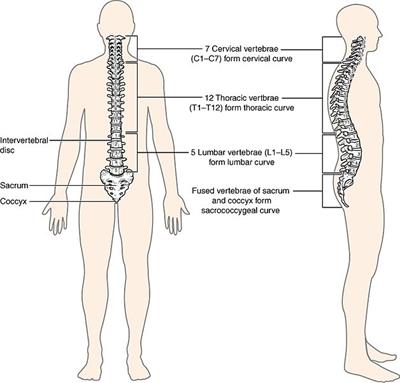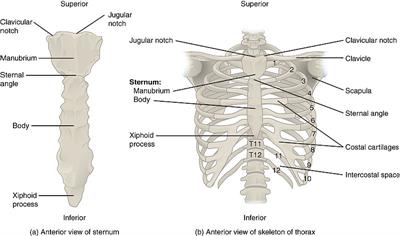
PUMPA - SMART LEARNING
எங்கள் ஆசிரியர்களுடன் 1-ஆன்-1 ஆலோசனை நேரத்தைப் பெறுங்கள். டாப்பர் ஆவதற்கு நாங்கள் பயிற்சி அளிப்போம்
Book Free DemoThe skeletal system comprises the bones and related structures aid in the body's movement. The skeletal system of humans is divided into two major parts:
The axial skeleton and the appendicular skeleton.
The axial skeleton and the appendicular skeleton.

Parts of skeleton
Axial skeleton
The skeleton that consists of the bones present along the axis or central line of the human
body is known as the axial skeleton. The axial skeleton consists of the skull, facial bones, sternum, ribs, and vertebral column.
body is known as the axial skeleton. The axial skeleton consists of the skull, facial bones, sternum, ribs, and vertebral column.
1. Skull:
The skull is a hard structure made up of many bones known as the cranial bones and facial bones. It is also known as the cranium or brain box. It is formed by \(22\) bones, out of which \(8\) bones are fixed together to form the cranium (cranial bones), and the other \(14\) bones fuse to form the face (facial bones).
All the bones of the skull except the bone that forms the lower jaw are immovable. The lower jaw bone is movable as it has a movable joint and is supported by muscles and ligaments. The lower jaw bone is the largest and the strongest in the human face. The skull is placed on top of the backbone can be moved up, down, and sidewards.

Skull
2. Vertebral Column:
It is also known as the spine or the backbone. It extends from the base of the skull to the hip bone forming a tube, and consists of many small bones called vertebrae that are \(33\ \)in number (during birth and later fuses into \(27\)) and are serially arranged.
The vertebral column is found in the trunk region to offer support to the upper part of the body. Out of the \(33\) vertebrae \(7\) are known as cervical vertebrae, \(12\) as lumbar vertebrae, \(5\)fused sacral and \(3\ \)fused coccygeal vertebrae. These vertebrae are joined by gliding joints that allow the body to bend backwards, frontwards and sidewards. The spinal cord passes through this hollow tube (vertebral column).

Vertebral column
Functions of the vertebral column:
- It is the structure that protects the spinal cord.
- It supports the head.
- It is a structure that serves as an attachment for the ribs.
- It provides support and serves as a place of attachment for the pectoral and pelvic girdle.
- It is responsible for the movement of the human skeleton.
- It aids during walking and standing erect with the correct posture.
3. Ribcage:
It is a cone-shaped structure that occupies the chest region. It is made up of \(12\ \)pairs of ribs that are attached to vertebrae at the back, curve around to form a cage.
Out of these \(12\) pairs, \(10\) pairs of the ribs are attached to the breast bone at the front (true ribs), \(2\ \)pairs of lower ribs are free at the front. These are known as free-floating ribs. The ribcage is set up in such a way so that it can contract and expand during the process of breathing. The ribcage protects the underlying lungs, heart and some part of the liver.

Ribcage
Important!
Humans are giraffes have same number of bones in the neck, but the they differ in sizes as the vertebrae in a giraffe’s neck are much, much larger.
Reference:
https://commons.wikimedia.org/wiki/File:601_Bone_Classification.jpg
https://commons.wikimedia.org/wiki/File:Human_skull_side_simplified_(bones)_CAT.svg
https://commons.wikimedia.org/wiki/File:715_Vertebral_Column.jpg
https://commons.wikimedia.org/wiki/File:721_Rib_Cage.jpg